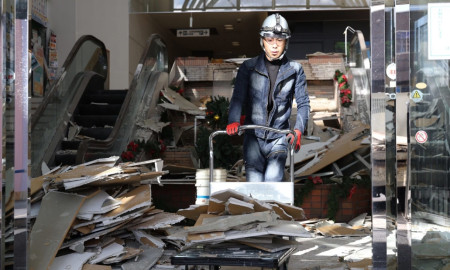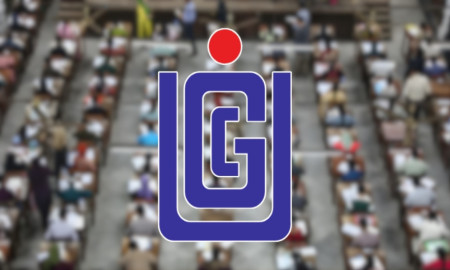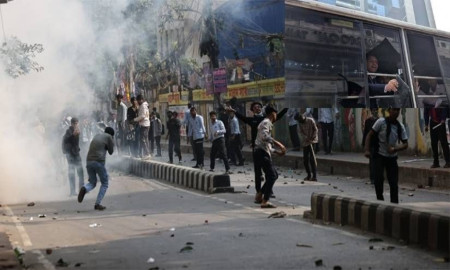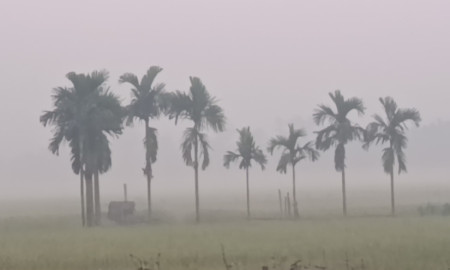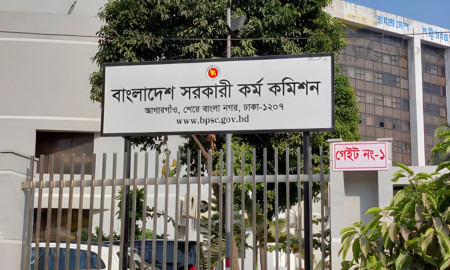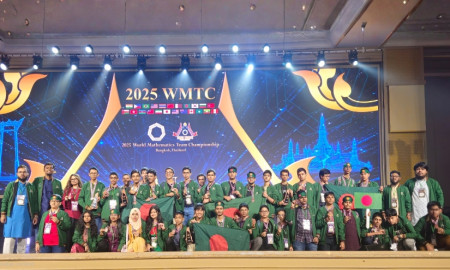Bangladesh’s Teachers Paid Least in Asia: Neighbours Earn Triple
Threefold Gap with Neighbours, Over Tenfold with Developed Nations
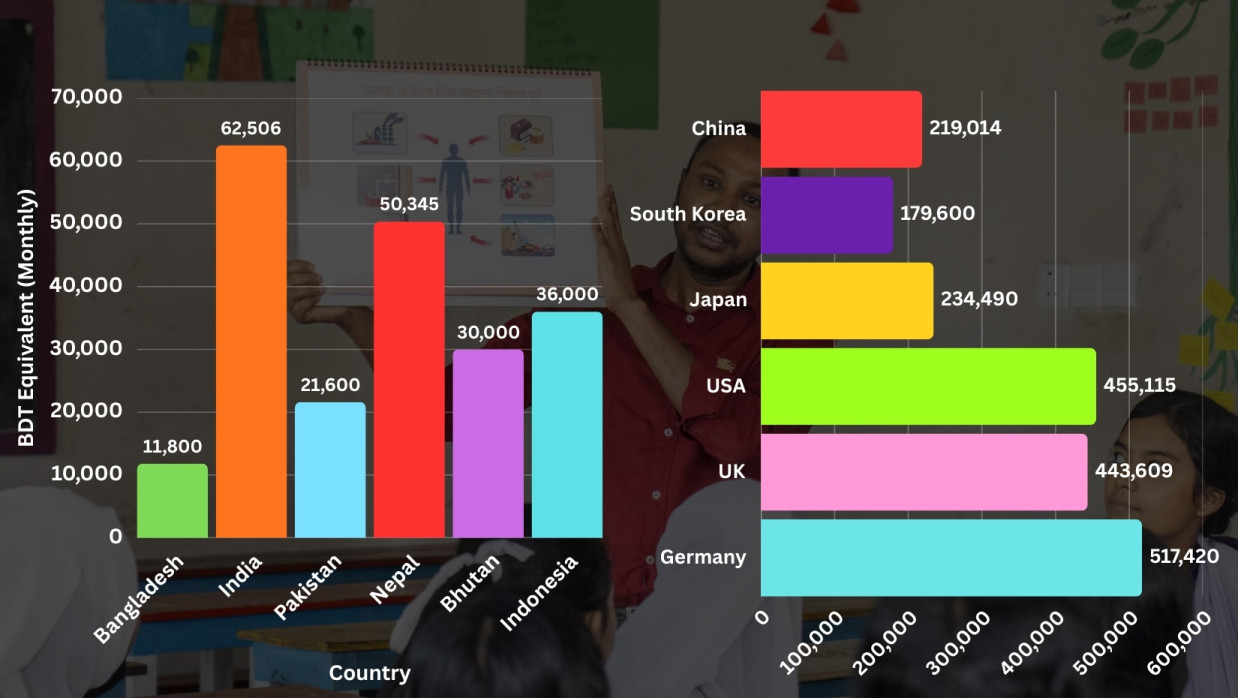
In the dim glow of a single bulb in a one-room flat in Mirpur, a school teacher counts coins for tomorrow’s bus fare. At 11,800 taka a month, he earns way less than the garment worker next door and far less than her counterparts in India or Nepal. With a new national pay scale looming for 2026, the crisis in Bangladesh’s classrooms is no longer a whisper—it’s a national emergency threatening the education of 18 million children.
The Stark Numbers: Entry-Level Pay in Bangladesh, 2025
Bangladesh operates under the 2015 National Pay Scale, with minor allowance adjustments effective November 1, 2025.
Junior teachers at School-2 level start at Grade 16 with a basic salary of 9,300 taka. Adding the minimum house rent allowance of 2,000 taka and medical allowance of 500 taka brings the gross monthly salary to 11,800 taka, which is equivalent to 97 USD.
Entry-level assistant teachers in general subjects (Bangla, English, Math, Science) start at Grade 11 with a basic of 12,500 taka, reaching 15,000 taka gross (123 USD) after allowances.
Special-subject teachers with a B.Ed. degree enter at Grade 10 with a basic of 16,000 taka, grossing 18,500 taka (152 USD) from November 2025, rising to 18,900 taka (155 USD) in July 2026 when house rent adjusts to 15% of basic.
A 10% pension deduction applies immediately. Annual benefits include a 5% increment on basic pay each July, two festival bonuses (25% of basic each), and one Boishakhi allowance (20% of basic). After 10 years, assistant teachers are promoted to Senior Teacher (Grade 9), starting at 22,000 taka basic.
 *Exchange rates (October 27, 2025)
*Exchange rates (October 27, 2025)
*House rent to rise to 2,400 BDT (15% of basic) from July 2026, increasing gross to 18,900 BDT (155 USD)
Regional Disparities: South Asia’s Pay Gap
Bangladesh ranks lowest in teacher compensation among its neighbors. India, Pakistan, Nepal, and Bhutan—all with comparable per capita GDP in nominal terms—offer significantly higher starting salaries. The gap is not just in numbers but in policy priority: these nations treat teaching as a middle-class profession, while Bangladesh pays below clerical grades. When adjusted for purchasing power parity, the situation for Bangladeshi teachers appears even more severe.
 *Exchange rates (October 27, 2025)
*Exchange rates (October 27, 2025)
Asia’s Broader Benchmark
Across Asia, even lower-middle-income nations outpace Bangladesh. Indonesia and China provide housing and certification incentives that lift real income. High performers like South Korea and Japan treat teaching as a high-status, high-pay career—correlating with top global learning outcomes.
 *Exchange rates (October 27, 2025)
*Exchange rates (October 27, 2025)
The Global Standard
In OECD nations, starting teacher salaries reflect investment in human capital. The United States, United Kingdom, and Germany offer pay that supports middle-class lifestyles, backed by benefits, pensions, and professional development—systems that produce consistent high performance in international assessments.
 *Exchange rates (October 27, 2025)
*Exchange rates (October 27, 2025)
The Coming Storm: A New Pay Scale in 2026?
The National Pay Commission, formed on July 24, 2025, is finalizing recommendations for a 9th National Pay Scale, with implementation targeted for January 2026. Preliminary reports suggest a 90% increase in basic pay and allowances, potentially raising assistant teachers’ gross to around 18,000–20,000 taka (148–164 USD). Monthly Pay Order (MPO) teachers may be fully integrated into the government scale.
However, past revisions have been eroded by inflation. Without indexing to cost of living or PPP benchmarks, any increase risks being symbolic. The commission has proposed narrowing the pay ratio from 15:1 to 12:1 between highest and lowest grades, but teachers demand for a better wage structure.
Why This Matters: Education, Economy, Equity
Low teacher pay drives systemic failure. A large portion of primary teachers are absent on any given day, according to reports. Many of them hold second jobs, reducing instructional time. The Annual Status of Education Report (ASER) 2024 found 70% of Grade 3 students cannot read a Grade 2 text—a stagnation linked directly to teacher motivation and capacity.
The economic cost is immense. The World Bank estimates that each 10% increase in teacher salary correlates with a 15% improvement in student learning outcomes. Scaled nationally, this could reduce learning poverty and boost long-term GDP growth by 0.5% annually through improved human capital.
Gender equity suffers too: Women comprise 60% of primary teachers but leave at twice the male rate due to financial stress, weakening STEM pipelines. Rural schools, already understaffed, lose talent to urban tutoring or migration.
Bangladesh spends just 1.53% of GDP on education—half the global SDG benchmark of 4–6%. Teacher salaries consume 70% of the education budget, yet deliver among the lowest returns in South Asia.
Expert Opinion
“Teachers must be valued differently from other professions,” said Professor Shah Shamim Ahmed of the Institute of Education and Research, University of Dhaka. “A teacher’s role can never be equated with that of a typical government officer. Teachers shape the nation’s future, so their pay structure must reflect that distinct importance.”
He added, “At present, most teachers earn between Tk 15,000 and 16,000 a month, which is far too low to support a family. As a result, many are forced to look for alternative income sources such as private tutoring or coaching. This financial strain affects their mental well-being and ultimately their students’ learning. When teachers are preoccupied with household crises, they lose the energy and focus needed for research or innovation in the classroom.”
“If we can ensure a fair, smart salary for teachers that allows them to live with dignity, the entire education system will benefit. A financially secure teacher is a more effective and inspired teacher. Considering current market conditions, teachers’ salaries should be two to three times higher than they are now,” he continued.
Professor Ahmed further emphasized, “It is unreasonable to keep teachers at the 16th grade, which is equivalent to that of office assistants in many cases. A teacher’s dignity must be recognized separately and cannot be compared with any other government employee. Ensuring that respect and adequate pay is essential if we truly want to improve the quality of education.”
Without these, Bangladesh risks entrenching a two-tier future: one where the children of the elite access quality schooling, and the rest inherit mediocrity. The classrooms of today are the factories and parliaments of tomorrow. Paying teachers like clerks guarantees a nation that thinks small.


